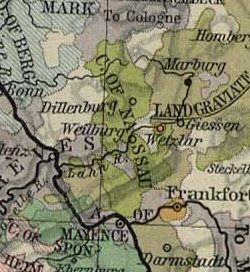Top Qs
Timeline
Chat
Perspective
County of Nassau
State of the Holy Roman Empire (1125–1806) From Wikipedia, the free encyclopedia
Remove ads
This article is about the former state in present-day Germany. For its ruling family, including its branches in present-day Netherlands and Luxembourg, see House of Nassau. For other uses, see Nassau County (disambiguation) and Nassau (disambiguation).
The County of Nassau was a German state within the Holy Roman Empire from the period of the formal recognition of the countly title in 1159 (though "de facto" sovereignty began in 1125) until the declaration of the Duchy of Nassau in 1806 with the creation of the Confederation of the Rhine . Through succession, it had many counts ruling parts of it, mostly or completely independent of one another. After many of these counts were promoted to princely status, the County was promoted and thus was known as a Princely County or as the Principality of Nassau.
Quick Facts (Gefürsteter) Grafschaft Nassau (German)Fürstentümer Nassau (German), Status ...
County of Nassau Princely County/Principality of Nassau Counties/(later) Principalities of Nassau | |||||||||
|---|---|---|---|---|---|---|---|---|---|
| 1125/1159–1806 | |||||||||
 County of Nassau in 1547 | |||||||||
| Status | County | ||||||||
| Capital | Nassau | ||||||||
| Common languages | German (Rhine Franconian dialects, Moselle Franconian dialects) | ||||||||
| Religion | Roman Catholic | ||||||||
| Historical era | Middle Ages | ||||||||
• Foundation of the city which is the namesake | 915 | ||||||||
• Countly title declared and non-recognized | 1125/1159 | ||||||||
• Recognition of the title | 1159 | ||||||||
• Splitings inside it because of sucession | 1255–1806 | ||||||||
• Declaration of the duchy | 1806 | ||||||||
| |||||||||
| Today part of | Germany | ||||||||
Close

Remove ads
Origins
Summarize
Perspective
Nassau, originally a county, developed on the lower Lahn river in what is known today as Rhineland-Palatinate. The town of Nassau was founded in 915.[1] Dudo of Laurenburg held Nassau as a fiefdom as granted by the Bishopric of Worms. His son, Rupert, built the Nassau Castle there around 1125, declaring himself "Count of Nassau". This title was not officially acknowledged by the Bishop of Worms until 1159 under the rule of Rupert's son, Walram. By 1159, the County of Nassau effectively claimed rights of taxation, toll collection, and justice, at which point it can be considered to become a state.[1]
The Nassauers held the territory between the Taunus and the Westerwald at the lower and middle Lahn. By 1128, they acquired the bailiwick of the Bishopric of Worms, which had numerous rights in the area, and thus created a link between their heritage at the lower Lahn and their possessions near Siegen. In the middle of the 12th century, this relationship was strengthened by the acquisition of parts of the Hesse-Thüringen feudal kingdom, namely the Herborner Mark, the Kalenberger Zent and the Court of Heimau (Löhnberg). Closely linked to this was the "Lordship of Westerwald", also in Nassau's possession at the time. At the end of the 12th century, the House acquired the Reichshof Wiesbaden, an important base in the southwest.
In 1255, after the Counts of Nassau acquired the estates of Weilburg, the sons of Count Henry II divided Nassau for the first time. Walram II received the county of Nassau-Weilburg. From 1328 on, his younger brother, Otto I, held the estates north of the Lahn river, namely the County of Nassau-Siegen and Nassau-Dillenburg. The boundary line was essentially the Lahn, with Otto receiving the northern part of the county with the cities of Siegen, Dillenburg, Herborn and Haiger and Walram retaining the section south of the river, including the cities of Weilburg and Idstein.
County of Nassau-Weilburg
Walram's son Adolf became King of Germany in 1292. His son Count Gerlach abdicated in 1344 and the county was divided under his sons in 1355
- County of Nassau-Weilburg, again divided from 1442 to 1574
- County of Nassau-Saarbrücken (Elder)
- County of Nassau-Weilburg
- County of Nassau-Wiesbaden, again divided from 1480 to 1509
- County of Nassau-Idstein
- County of Nassau-Wiesbaden
fell back to Nassau-Weilburg in 1605
- County of Nassau-Sonnenberg, partitioned among Nassau-Wiesbaden and Nassau-Weilburg in 1405
In 1605, all parts of Nassau-Weilburg were again unified under Count Louis II; however, after his death in 1627, his sons divided the county again
- County of Nassau-Idstein, fell to Nassau-Ottweiler in 1721
- County of Nassau-Saarbrücken (Younger), divided again in 1640
- County of Nassau-Saarbrücken, fell to Nassau-Ottweiler in 1723
- County of Nassau-Ottweiler, fell to Nassau-Usingen in 1728
- County of Nassau-Usingen, Principality in 1688
- County of Nassau-Weilburg (Younger)
After Nassau-Usingen had inherited Nassau-Ottweiler with former Nassau-Idstein and Nassau-Saarbrücken, it was reunified with Nassau-Weilburg and raised to the Duchy of Nassau in 1806.
County of Nassau-Dillenburg
After the death of Count Otto I, his county was divided between his sons in 1303:
- County of Nassau-Dillenburg, fell to Nassau-Siegen in 1328
- County of Nassau-Hadamar (Elder), fell to Nassau-Dillenburg in 1394
- County of Nassau-Siegen, called Nassau-Dillenburg from 1328 on, again got divided from 1341 to 1561:
- County of Nassau-Beilstein (Elder)
- County of Nassau-Dillenburg (Elder)–1606)
In 1504, Henry III of Nassau-Dillenburg inherited the county's estates at Breda in the Duchy of Brabant, while his younger brother William became Count of Nassau-Dillenburg in 1516. After the son of Henry III, René of Châlon died in 1544, Count William's eldest son William the Silent became Prince of Orange and Lord of Breda, Stadtholder in the Low Countries from 1559 on. His younger brother, John VI, again reunited all Nassau-Dillenburg possessions in 1561, though the county was again divided after his death in 1606.
- County of Nassau-Hadamar (Younger), Principality in 1650, fell to Nassau-Diez in 1743
- County of Nassau-Siegen, (1607–23), again got divided from 1623 to 1734:
- County of Nassau-Siegen (Protestant), Principality in 1664, became extinct in 1734
- County of Nassau-Siegen (Catholic), Principality, fell to Nassau-Diez in 1743
- County of Nassau-Dillenburg, fell to Nassau-Beilstein in 1620
- County of Nassau-Beilstein (Younger), called Nassau-Dillenburg (Younger) from 1620 on, Principality in 1652, fell to Nassau-Dietz in 1739
- County of Nassau-Dietz, fell to Joachim Murat's Grand Duchy of Berg after the dissolution of the Holy Roman Empire in 1806
The Counts of Nassau-Dietz, descendants of William Frederick were stadtholders of Friesland, Groningen and Drenthe and Princes of Orange from 1702 on. When they lost their Dutch possessions during the Napoleonic Wars, they were compensated with the Principality of Nassau-Orange-Fulda. Though they lost their German possessions in 1806, the House of Orange-Nassau, through female succession, was the reigning house of the Grand Duchy of Luxembourg until 1890 and is still the royal house of the Netherlands.
Remove ads
Rulers
Summarize
Perspective
House of Nassau
Partitions of Nassau under Nassau rule
| County of Laurenburg/ Nassau (1093-1255) | |||||||||||||||||||||||||||||
 County of Northern Nassau (Ottonian Line) (1255-1303) |
 County of Southern Nassau (Walramian Line) (1255-1355) | ||||||||||||||||||||||||||||
| County of Dillenburg (1st creation) (1303-1328) |
County of Hadamar (1st creation) (1303-1394) | ||||||||||||||||||||||||||||
| County of Beilstein (1343-1561) |
|||||||||||||||||||||||||||||
| County of Sonnenberg (1355-1404) |
|||||||||||||||||||||||||||||
 County of Weilburg (1355-1806) | |||||||||||||||||||||||||||||
| County of Siegen (1303-1652/64) |
 Barony of Breda (1403-1544) Renamed as:  Principality of Orange-Nassau (1st creation, Siegen-Breda line) (1544-1702)[2] |
County of Wiesbaden-Idstein (1st creation) (1355-1605) (divided 1370-86; 1480-1509; 1554-56; 1564-66) | |||||||||||||||||||||||||||
 County of Saarbrücken (1st creation) (1429-1574) | |||||||||||||||||||||||||||||
| County of Hadamar (2nd creation) (1620-1650) Raised to: Principality of Hadamar (1650-1711) |
(In 1623 divided in Catholic and Protestant ruling lines) Both lines raised to: Catholic Principality of Siegen (1652-1743) and  Protestant Principality of Siegen (1664-1734) |
||||||||||||||||||||||||||||
| County of Idstein (2nd creation) (1627-1688) Raised to: Principality of Idstein (1688-1721) | |||||||||||||||||||||||||||||
| County of Ottweiler (1659-1721) |
|||||||||||||||||||||||||||||
 County of Dillenburg (2nd creation) (1606-1654) Raised to:  Principality of Dillenburg (1654-1739) |
|||||||||||||||||||||||||||||
 County of Dietz (1606-1654) Raised to:  Principality of Dietz (1654-1702) |
 County of Saarbrücken (2nd creation) (1627-1728) | ||||||||||||||||||||||||||||
Renamed as: Principality of Orange-Nassau (2nd creation, Dietz line) (1702-1806) |
County of Usingen (1659-1688) Raised to: Principality of Usingen (1688-1806) | ||||||||||||||||||||||||||||
| Principality of Saarbrücken (1741-1797) | |||||||||||||||||||||||||||||
| Annexed by France | |||||||||||||||||||||||||||||
 Principality of Orange-Nassau (2nd creation, Dietz line) (1813-1815) |
Duchy of Nassau (1806-1866) | ||||||||||||||||||||||||||||
| Annexed by Prussia | |||||||||||||||||||||||||||||
More information Table of rulers, Ruler ...
Table of rulers | |||||||||||||||||||||||||||||||||||||||||||||||||||||||||||||||||||||||||||||||||||||||||||||||||||||||||||||||||||||||||||||||||||||||||||||||||||||||||||||||||||||||||||||||||||||||||||||||||||||||||||||||||||||||||||||||||||||||||||||||||||||||||||||||||||||||||||||||||||||||||||||||||||||||||||||||||||||||||||||||||||||||||||||||||||||||||||||||||||||||||||||||||||||||||||||||||||||||||||||||||||||||||||||||||||||||||||||||||||||||||||||||||||||||||||||||||||||||||||||||||||||||||||||||||||||||||||||||||||||||||||||||||||||||||||||||||||||||||||||||||||||||||||||||||||||||||||||||||||||||||||||||||||||||||||||||||||||||||||||||||||||||||||||||||||||||||||||||||||||||||||||||||||||||||||||||||||||||||||||||||||||||||||||||||||||||||||||||||||||||||||||||||||||||||||||||||||||||||||||||||||||||||||||||||||||||||||||||||||||||||||||||||||||||||||||||||||||||||||||||||||||||||||||||||||||||||||||||||||||||||||||||||||||||||||||||||||||||||||||||||||||||||||||||||||||||||||||||||||||||
|---|---|---|---|---|---|---|---|---|---|---|---|---|---|---|---|---|---|---|---|---|---|---|---|---|---|---|---|---|---|---|---|---|---|---|---|---|---|---|---|---|---|---|---|---|---|---|---|---|---|---|---|---|---|---|---|---|---|---|---|---|---|---|---|---|---|---|---|---|---|---|---|---|---|---|---|---|---|---|---|---|---|---|---|---|---|---|---|---|---|---|---|---|---|---|---|---|---|---|---|---|---|---|---|---|---|---|---|---|---|---|---|---|---|---|---|---|---|---|---|---|---|---|---|---|---|---|---|---|---|---|---|---|---|---|---|---|---|---|---|---|---|---|---|---|---|---|---|---|---|---|---|---|---|---|---|---|---|---|---|---|---|---|---|---|---|---|---|---|---|---|---|---|---|---|---|---|---|---|---|---|---|---|---|---|---|---|---|---|---|---|---|---|---|---|---|---|---|---|---|---|---|---|---|---|---|---|---|---|---|---|---|---|---|---|---|---|---|---|---|---|---|---|---|---|---|---|---|---|---|---|---|---|---|---|---|---|---|---|---|---|---|---|---|---|---|---|---|---|---|---|---|---|---|---|---|---|---|---|---|---|---|---|---|---|---|---|---|---|---|---|---|---|---|---|---|---|---|---|---|---|---|---|---|---|---|---|---|---|---|---|---|---|---|---|---|---|---|---|---|---|---|---|---|---|---|---|---|---|---|---|---|---|---|---|---|---|---|---|---|---|---|---|---|---|---|---|---|---|---|---|---|---|---|---|---|---|---|---|---|---|---|---|---|---|---|---|---|---|---|---|---|---|---|---|---|---|---|---|---|---|---|---|---|---|---|---|---|---|---|---|---|---|---|---|---|---|---|---|---|---|---|---|---|---|---|---|---|---|---|---|---|---|---|---|---|---|---|---|---|---|---|---|---|---|---|---|---|---|---|---|---|---|---|---|---|---|---|---|---|---|---|---|---|---|---|---|---|---|---|---|---|---|---|---|---|---|---|---|---|---|---|---|---|---|---|---|---|---|---|---|---|---|---|---|---|---|---|---|---|---|---|---|---|---|---|---|---|---|---|---|---|---|---|---|---|---|---|---|---|---|---|---|---|---|---|---|---|---|---|---|---|---|---|---|---|---|---|---|---|---|---|---|---|---|---|---|---|---|---|---|---|---|---|---|---|---|---|---|---|---|---|---|---|---|---|---|---|---|---|---|---|---|---|---|---|---|---|---|---|---|---|---|---|---|---|---|---|---|---|---|---|---|---|---|---|---|---|---|---|---|---|---|---|---|---|---|---|---|---|---|---|---|---|---|---|---|---|---|---|---|---|---|---|---|---|---|---|---|---|---|---|---|---|---|---|---|---|---|---|---|---|---|---|---|---|---|---|---|---|---|---|---|---|---|---|---|---|---|---|---|---|---|---|---|---|---|---|---|---|---|---|---|---|---|---|---|---|---|---|---|---|---|---|---|---|---|---|---|---|---|---|---|---|---|---|---|---|---|---|---|---|---|---|---|---|---|---|---|---|---|---|---|---|---|---|---|---|---|---|---|---|---|---|---|---|---|---|---|---|---|---|---|---|---|---|---|---|---|---|---|---|---|---|---|---|---|---|---|---|---|---|---|---|---|---|---|---|---|---|---|---|---|---|---|---|---|---|---|---|---|---|---|---|---|---|---|---|---|---|---|---|---|---|---|---|---|---|---|---|---|---|---|---|---|---|---|---|---|---|---|---|---|---|---|---|---|---|---|---|---|---|---|---|---|---|---|---|---|---|---|---|---|---|---|---|---|---|---|---|---|---|---|---|---|---|---|---|---|---|---|---|---|---|---|---|---|---|---|---|---|---|---|---|---|---|---|---|---|---|---|---|---|---|---|---|---|---|---|---|---|---|---|---|---|---|---|---|---|---|---|---|---|---|---|---|---|---|---|---|---|---|---|---|---|---|---|---|---|---|---|---|---|---|---|---|---|---|---|---|---|---|---|---|---|---|---|---|---|---|---|---|---|---|---|---|---|---|---|---|---|---|---|---|---|---|---|---|---|---|---|---|---|---|---|---|---|---|---|---|---|---|---|---|---|---|---|---|---|---|---|---|---|---|---|---|---|---|---|---|---|---|---|---|---|---|---|---|---|---|---|---|---|---|---|---|---|---|---|---|---|---|---|---|---|---|---|---|---|---|---|---|---|---|---|---|---|---|---|---|---|---|---|---|---|---|---|---|---|---|---|---|---|---|---|---|---|---|---|---|---|---|---|---|---|---|---|---|---|---|
| |||||||||||||||||||||||||||||||||||||||||||||||||||||||||||||||||||||||||||||||||||||||||||||||||||||||||||||||||||||||||||||||||||||||||||||||||||||||||||||||||||||||||||||||||||||||||||||||||||||||||||||||||||||||||||||||||||||||||||||||||||||||||||||||||||||||||||||||||||||||||||||||||||||||||||||||||||||||||||||||||||||||||||||||||||||||||||||||||||||||||||||||||||||||||||||||||||||||||||||||||||||||||||||||||||||||||||||||||||||||||||||||||||||||||||||||||||||||||||||||||||||||||||||||||||||||||||||||||||||||||||||||||||||||||||||||||||||||||||||||||||||||||||||||||||||||||||||||||||||||||||||||||||||||||||||||||||||||||||||||||||||||||||||||||||||||||||||||||||||||||||||||||||||||||||||||||||||||||||||||||||||||||||||||||||||||||||||||||||||||||||||||||||||||||||||||||||||||||||||||||||||||||||||||||||||||||||||||||||||||||||||||||||||||||||||||||||||||||||||||||||||||||||||||||||||||||||||||||||||||||||||||||||||||||||||||||||||||||||||||||||||||||||||||||||||||||||||||||||||||
Close
Remove ads
Nassau's successor states
Main articles: List of monarchs of Luxembourg and List of monarchs of the Netherlands
Kings and Queens of the Netherlands (from the House of Orange-Nassau-Dietz)

- 1815–1840: William I, also Duke and Grand Duke of Luxemburg and Duke of Limburg
- 1840–1849: William II, also Grand Duke of Luxemburg and Duke of Limburg
- 1849–1890: William III, also Grand Duke of Luxemburg and Duke of Limburg
- 1890–1948: Wilhelmina
Following defunct German laws that no longer have relevance due to the end of German nobility, the House of Orange-Nassau(-Dietz) has been extinct since the death of Wilhelmina (1962). Dutch laws and the Dutch nation do not consider it extinct.
- 1948–1980: Juliana
- 1980–2013: Beatrix
- 2013-present: Willem-Alexander
Grand Dukes of Luxembourg (from the House of Nassau-Weilburg)
Main article: Grand Ducal Family of Luxembourg

- 1890–1905: Adolphe
- 1905–1912: William IV
- 1912–1919: Marie-Adélaïde, succession through a female onwards
- 1919–1964: Charlotte
- 1964–2000: Jean
- 2000–present: Henri
See also
References
Wikiwand - on
Seamless Wikipedia browsing. On steroids.
Remove ads
Remove ads




























































































